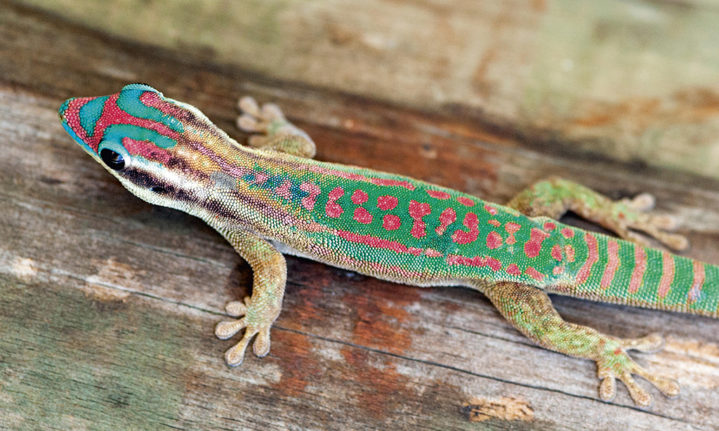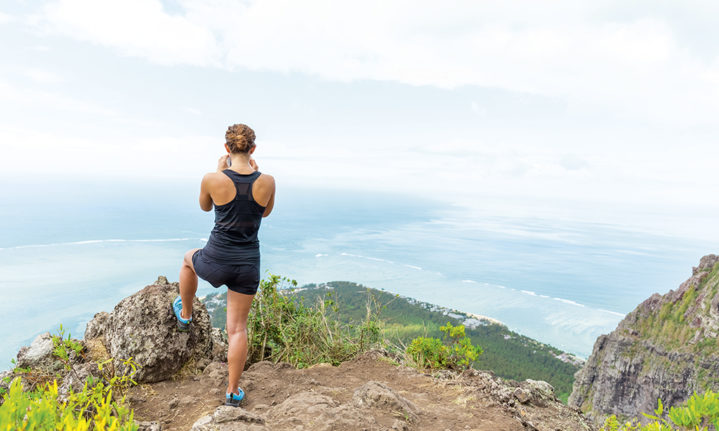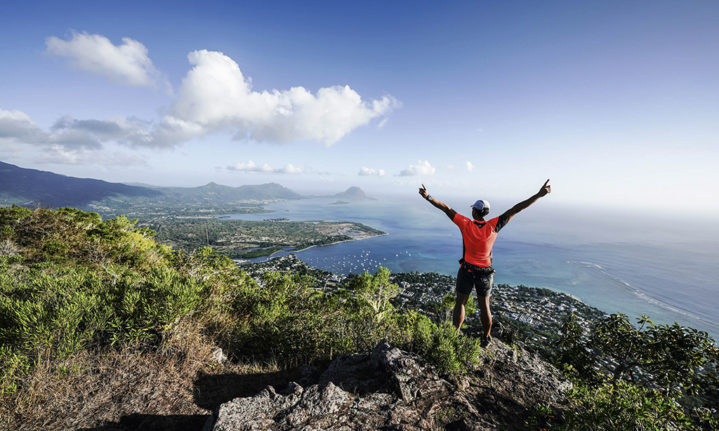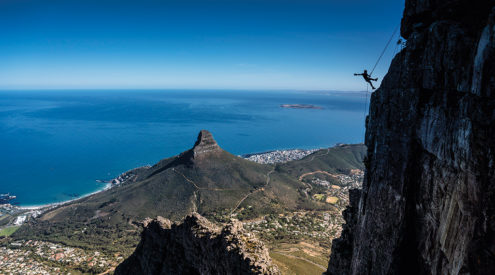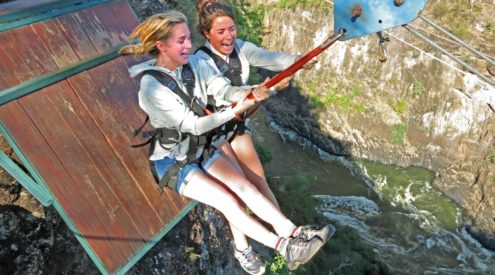My first visit to Mauritius was with a friend, on the cheap and on a whim. He had frequent-flyer miles to burn, I had wanderlust. The days there were leisurely, spent mostly on the beach, exploring Grand Baie and Pereybere in the north. At night? It was low season and in 2012 few venues stayed open late in this popular tourist hotspot. Even my three-star-hotel bar closed early, so I was confined in my floor-to-ceiling-coral-pink room with three channels of French TV for entertainment. My travelling companion went out on dates he’d set up online. I had no idea. His saving grace, however, was his willingness to drive me south for a day at Shanti Maurice, where we enjoyed one of the most unforgettable spa treatments ever.
That was my first taste of travel across the island – past sugar-cane fields and volcanic mountains, along narrow tree-lined roads without pavements and some stretches of highway that eased our journey a little. My next visit to Mauritius was the opposite extreme – at the One&Only Le Saint Géran, on a private peninsula in the east. As wonderful as it was to live that cosseted resort life, I still felt the pull to explore further. On subsequent trips, I hired a car, acquired a Mauritian cellphone number, a dodo tattoo and a half-decent French accent. And went walking…
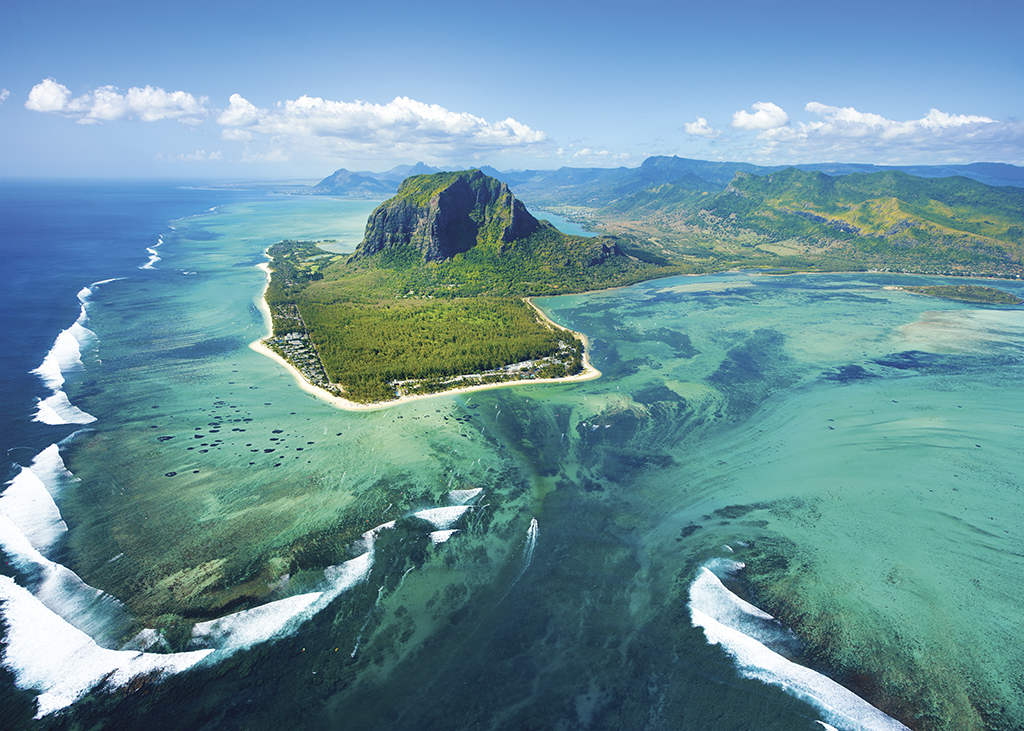
Le Morne Brabant peninsula, topped by a basalt monolith (worth the hike) and surrounded by lagoons, is a popular tourist spot in the south-west of Mauritius. It’s named after a Dutch East India Company ship, Brabant, which ran aground on the reef in 1793. The peninsula remains a place of local myth and legend.
1. Up Le Morne Brabant

Le Morne Brabant
My first trip across the island to Shanti Maurice took us within sight of Le Morne Brabant in the south-west, a Unesco World Heritage Site known for the shelter it provided runaway slaves in the 18th and 19th centuries. I was determined to climb this monolithic mountain and took the advice of local photographer Anoop Jahul to start early in the morning before it got too hot.
Although not essential on this hike, a guide will share the history of the site and point out one of the features of the coast that you can only see from a bird’s view: it’s a drop-off that forms where the reef gives way to deep open ocean, creating the illusion of an underwater waterfall.
Le Morne Brabant is the most strenuous hike I’ve done so far in Mauritius, and you need to allow between three and four hours if you’re moderately fit. The ascent begins slowly, becoming more taxing and ‘technical’ the higher you climb. Think Cape Town’s Lion’s Head, but more challenging (and without the help of chains). The final section to the top of Le Morne is a tricky climb which I didn’t attempt. Some experienced hikers completed the ascent in about two hours at pace, and said they were rewarded with 360-degree views that took their breath away. You should only do this last bit roped, and with a guide.
Do it Signs clearly indicate the dirt road turn-off to the visitor’s centre where you park (or type ‘Le Morne trail entrance’ into Google Maps). Take your own water and snacks, as there’s nothing to buy on site. There’s no cost to hike and a guide is not essential, but contact Local Spirit if you’d like one for R493 pp (Rs1,200). localspirit.mu
2. Through La Vallée De Ferney

A must-see sanctuary for Mauritian biodiversity, La Valleé de Ferney can be explored on an easy trail through the Bambous Mountains.
La Vallée de Ferney is a 200-hectare forest and wildlife sanctuary for rare or endangered indigenous tree species, including ebony trees, takamakas and the Ravenala (or Traveller’s Tree), on the eastern side of the island. Alarmingly, less than two per cent of the indigenous ecosystems on Mauritius are still intact.
Day visitors can visit the sanctuary all year round, and there’s a three-kilometre walk (allow about 90 minutes) that takes you into the partially rehabilitated forest and out onto the plains, for beautiful views of the south-east of the island. You’ll share the space with shy deer and might be escorted by the illusive Mauritian falcon (also known as the kestrel), found only on this island. Thanks to the Mauritian Wildlife Foundation and the National Park Conservation services, the island has around 400 kestrels, including 15 pairs within La Vallée de Ferney.
The reserve is the setting for the Ciel Ferney Trail Run (ferneytrail.com), easily the single largest sporting event on the island in terms of number of participants. With 2,500 metres of elevation, this 50-kilometre run, held in September, is challenging, but it offers a chance to traverse one of the last areas of indigenous flora and fauna on the island. There are also four-kilometre, 10-kilometre and 20-kilometre routes, offering views over the wild southeastern part of the island and its turquoise lagoon. Come for the race, then stay and holiday afterwards.
Do it After your hike, watch the kestrels being fed at noon before enjoying lunch at the restaurant. Park entry fee, including kestrel feeding, is R377 per person (Rs900); add R105 per person (Rs250) for a guide. +230-634-0440, travelomauritius.com
3. Round Île Des Deux Cocos

As long as you’re gaining elevation, you’ll get memorable views – this is atop La Tourelle, overlooking Tamarin Bay.
If a gentle stroll on an islet holds more appeal, head to Blue Bay in the south-east where you catch the ferry to Île des Deux Cocos in the Blue Bay Marine Reserve. This privately-owned island, located near the international airport, offers day visitors a special excursion to a place where the only traffic is the procession of fish between coral outcrops. Make a day of it, at least.
I love being at the sea, and this islet is one of my favourite haunts. It was the 1920s domain of Governor Hesketh Bell, whose platoon would arrive every Friday and hoist a flag to announce his imminent weekend stay at his eccentrically-charming two-bedroom villa (still the only accommodation on the island, luxresorts.com). Flying the flag would prevent anybody else attempting to access the island, other than his invited guests.
Île des Deux Cocos is small – if you’re striding out, you’ll lap strollers in 20 minutes – and yet it never feels crowded. Organised day trips include activities such as beach volleyball, badminton, frisbee, giant chess, a glass-bottomed-boat trip and snorkelling. After indulging in the culinary delights of the open-air restaurant and tasting the local rum infusions, you can recline on a lounger, read a book or simply absorb the beauty of the surroundings.
Do it The all-inclusive day trip costs R1,532 per person (Rs3,350) for adults and R785 per person (Rs1,870) for kids aged six to 11. Catch the boat from the jetty in Blue Bay at 10am, returning at 3pm. Iledesdeuxcocos.com
4. Across Île Aux Aigrettes
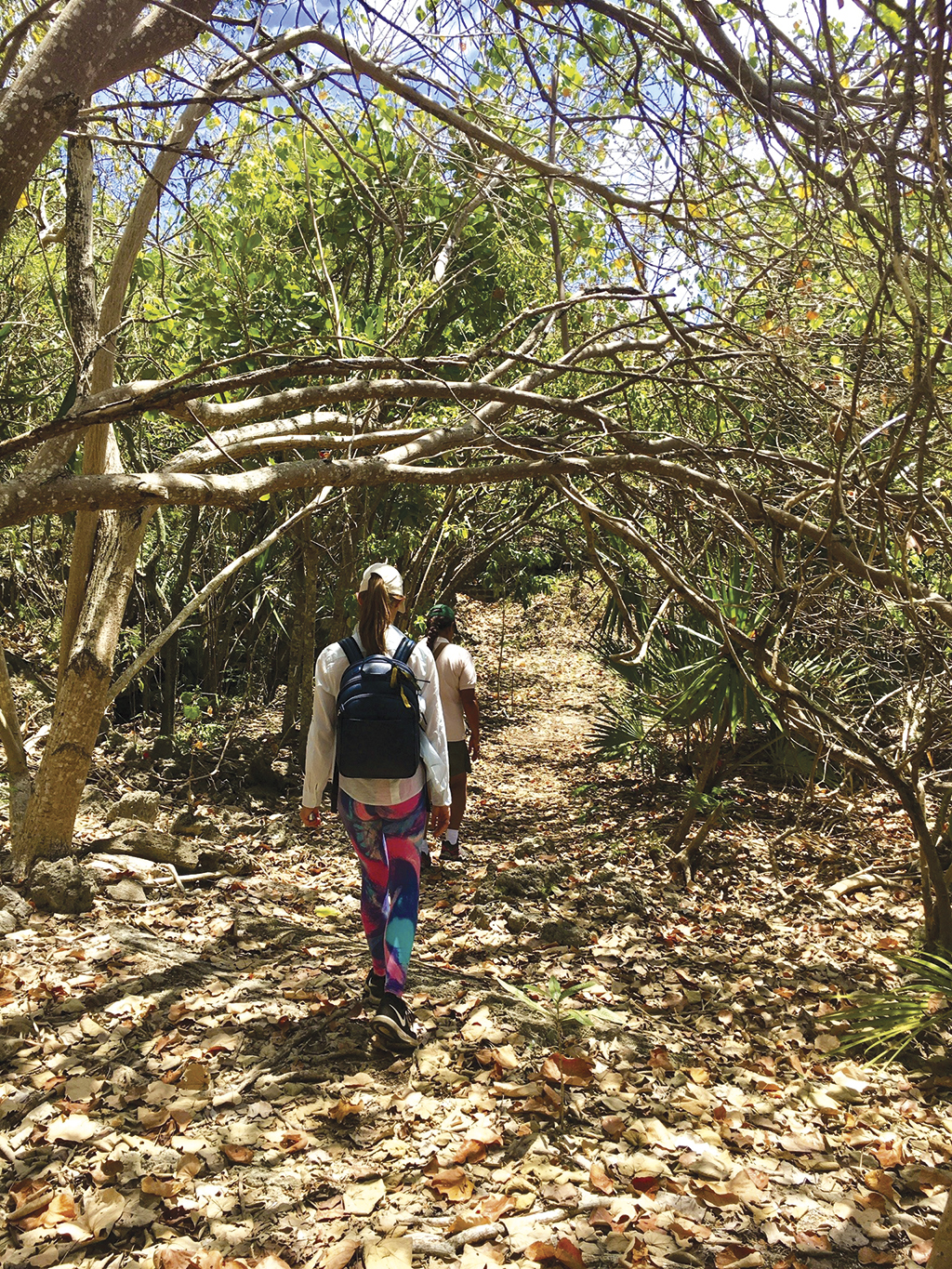
It’s hot and humid in Île aux Aigrettes nature reserve and Lycra tights are a good barrier from marauding mosquitoes – but insect repellent is a must for any hike.
Île aux Aigrettes is a 27-hectare nature reserve in Mahebourg Bay, less than a kilometre off the south-east coast of Mauritius. This islet differs from the mainland, which is of volcanic origin, in that it is made of coralline limestone. Visitors can walk a rugged trail through remnants of dry coastal forest once found around most of Mauritius. The guided tour takes about two hours and is a leisurely walk over mostly flat ground, with plenty of time to stop and admire the rare endemic species of flora and fauna as well as the pink pigeons, ornate day geckos, ebony forest and giant Aldabra tortoises.
It was particularly hot the day I walked this trail; the tortoises literally nose-dived into their water troughs to drink, precariously poised at such an angle I feared they might not be able to rock back onto all fours again. It was quiet and peaceful there, and I felt privileged to be in such a special place of conservation. Along with the echo parakeet, the pink pigeon has come close to extinction, but their presence there demonstrates the success of the efforts of the Mauritian Wildlife Foundation to protect them.
Do it Book the guided walk in advance; tickets cost R335 per person (Rs800) for adults and R168 (Rs400) for kids aged four to 11. The boat to the island leaves from the old Sands Jetty at Pointe Jerome half-hourly from 9.30am to 2.30pm, and on Sundays in the morning only. mauritian-wildlife.org.
Other walks to try
5. Domaine de L’étoile
This 1,200-hectare private nature reserve in the south-east has trails to the top of the Bambou mountain range from where you’ll get splendid views over the eastern and southern coastline. There’s also horse riding, a 3.5-kilometre zip line, children’s adventure village and a restaurant serving traditional Mauritian cuisine. mauritiusattractions.com
6. Îot Mangénie
Only guests staying at Shangri-La’s Le Touessrok Resort & Spa can take a skiff from the jetty to this private 46-hectare islet with a beach club and butlers. You can walk all the way round this islet in about 20 minutes and cross (at low tide) to the watersports hub on the neighbouring island, Île Aux Cerfs. shangri-la.com
Plan your trip
Getting there
Air Mauritius operates daily flights from Johannesburg, three times a week from Durban and twice-weekly from Cape Town; some flights are code-shared with SAA. Prices start at around R8,000 return but there are significant seasonal differences. airmauritius.com, flysaa.com
Need to know
South African passport holders don’t need a visa for Mauritius. The best weather is from April to June as well as September to December. The air quality in Mauritius was rated one of the best in the world by the United Nations Environment Programme (Unep) in 2015. But in the dense forests of the nature reserves, I found myself short of breath, which is to be expected in the hot and humid tropics. Due to this heat, it’s best to start walking soon after sunrise. Pack mozzie repellent, light-cotton and Lycra clothing for hiking.
Where to stay
In Mauritius it’s time- and energy-efficient to focus your efforts in one area, so book accommodation as close as possible to the activities you want to do (the wilder south is best for nature and birding). Hire a car or find a local taxi service – which is cheaper. A self-catering villa or guest house is a good alternative to a resort. booking.com
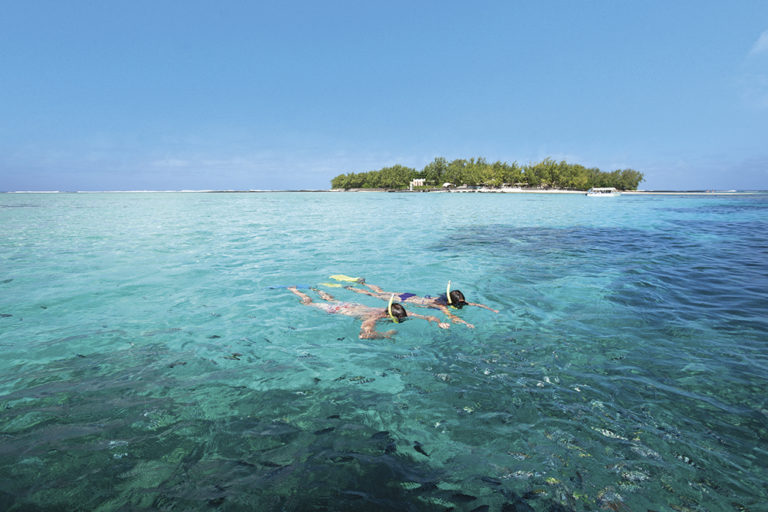
It’s easy to imagine being a castaway on this little gem; Île des deux Cocos is ranked among the top private islands in the world. Walking along the secluded paths is calming and peaceful, and the snorkelling is not too shabby either.
Words: Debbie Hathaway











